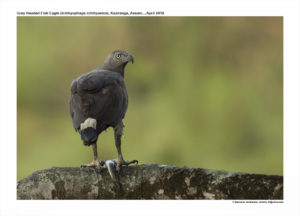Grey-headed Fish Eagle

Grey -headed Fish Eagle Ichthyophaga ichthyaetus
Etymology:
- Ichthyophaga: Greek word ikhthus – fish ; phagos–eating { Fish Eating}
- Ichthyaetus : Greek Word ikhthus – fish ; aetos –eagle ( Fish Eagle}
Vernacular Name: Hindi: Madhuya, Ben: Machhmoral, Cachar: Na daoling, Guj: Rakhodisirmachhimaar, Rakhodishirmatsyagarud, gadeba, Ta: Vidaiali, Sinh: Wewarajaliya, Lulmara, Mar: RakhidokyachaMatsyagarud
Distribution in India: Resident in Coastal Karnataka, Kerala, Some parts of Maharashtra, Madhya Pradesh and East India.
Description: Size of 61–75 cm; Wt. of 1600–2700 g; wingspan of 155–170 cm. It is a medium-sized brownish-grey fishing-eagle, with relatively small head and bill is grey, and belly is white; white base of tail; iris is yellow, cere is grey-brown to blackish-grey, and legs are greyish-white to pale yellowish-grey. The female is larger than male and apparently much heavier. The juvenile is brown, with underparts usually heavily streaked white , iris is brown .
Habitat:It is found in large wet forests bordering humid meadows, bogs, marshes and other wetlands including mangroves; occasionally on mudflats associated with large rivers and estuaries Lowland forests, closely associated with large bodies of fresh water, in particular sluggish streams, and large ponds. Found also at rivers, reservoirs and marshes.
Food Habits: It’s a specialist Piscivore hence eats mainly fish; also some terrestrial birds and small mammals. The most common method of foraging used is to catch fish from a hunting perch close to a water source with a short flight to snatch prey on the water surface or just below.Also quarters over stretches of river or lakes and fish too heavy to lift may be dragged to bank to devour. It is also dynamic in prey pursuit and can catch fish in rough water such as rapids.Both species in the genus Ichthyophaga have strongly re-curved talons like the osprey. Will also eat dead fish.
Breeding Habits: They breed in Nov –Jan in India. Adults are quite vocal during courtship. They build huge stick nest up in tall tree in forest, near lake or sluggish stream; in seasonally flooded swamp-forest preferring trees closer to permanent water than expected, preference for proximity to water reflecting some advantage in terms of prey availability The nests are used for several years in succession.They lay a clutch of 1–2 eggs. The incubation is done by both sexes for a period of 28–30 days. The chicks are hatched as altricial and the fledging period is 10 weeks.